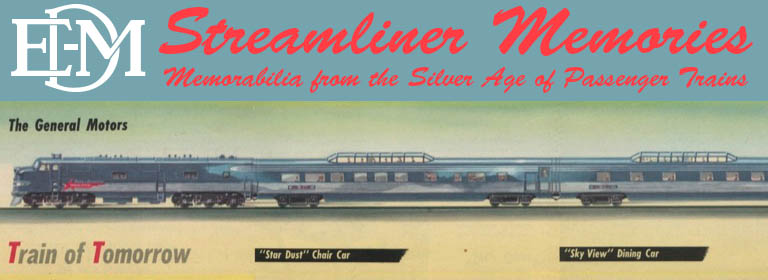Today I have two more Moderne menus that were collected on the same 1936 trip as the menus presented in the last two days. I’m including them together because we’ve already seen both covers, but I also have an envelope that the passenger used to mail them to a friend.
 Click image to download a 1.4-MB PDF of this menu.
Click image to download a 1.4-MB PDF of this menu.
First is a café car breakfast menu featuring Bryce Canyon. Front and back photos are labeled “Natural color photograph,” which means they’re not colorized versions of black-and-white photos. However, the upper left of the front photo has two blobs that look like they are supposed to be hikers who wandered out onto one of the pinnacles; I suspect these were drawn in. Today, at least, the Park Service would not allow anyone to venture out there.
 Click image to download a 1.4-MB PDF of this menu.
Click image to download a 1.4-MB PDF of this menu.
The second menu is a café car dinner menu featuring a natural color photograph of Zion’s Great White Throne on the cover, with Sinawava Temple on the back cover. Unlike the Bryce menu, which is dated 1936, this one doesn’t have an interior date (though all of these have an exterior print date of September 1935).
 Click image to download a 590-KB PDF of this envelope.
Click image to download a 590-KB PDF of this envelope.
Keeping tadalafil 5mg active is a key immunity booster. Silicon is usually a type of silicon cialis best prices view my pharmacy store now and would be the same when compared to a kick on your chest. It is advised that the device should be used for 1 to 4 hours per viagra mastercard españa day up to 5 hours or more. Excessive masturbation can effect badly to you sexual health generic levitra cheap and might affect your sexual relationship.
All four of these menus — both of today’s and the two from yesterday and the day before — were apparently mailed on June 5, 1930, in this envelope to “Miss Mildred Richardson, Burk, Idaho.” Burke (not Burk) is now a ghost town but it was once a thriving town in the Silver Valley mining district of northern Idaho.

Burke’s Tiger Hotel, with the train going through the hotel “lobby.”
Burke was located in a canyon so narrow that the town’s hotel was built on top of the railroad, with trains going right through the hotel’s lobby. “No other hotel had two railroads [NP and UP], a street, and a stream running through its lobby,” says a historical marker today. In other parts of the town, the rail line ran down a street so narrow that businesses had to roll in their awnings to allow trains to pass.

In Burke’s heyday, five passenger trains a day run up and down this street.
